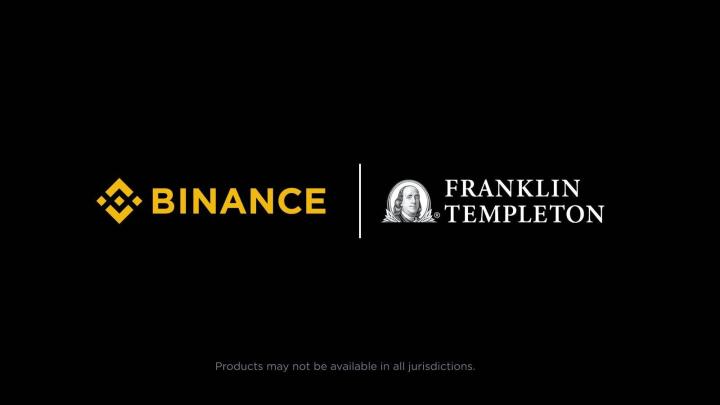Author: 0xCousin
I. Who is behind Ethena?
Ethena's team members
Ethena's team members have diverse backgrounds and deep expertise and practical experience in Crypto, finance, and technology.
Founder G (Guy Young) previously worked at a $60 billion hedge fund, and after the Luna collapse, he founded Ethena; COO Elliot Parker was previously a product manager at Paradigm and also worked at Deribit; Jane Liu, Head of Institutional Growth in the Asia-Pacific region, was previously the Investment Research Head at Fundamental Labs and the Institutional Partnership and Fund Relations Manager at Lido Finance.
Ethena's financing
According to Rootdata information, Ethena has completed three rounds of financing, with a total of $119.5 million raised. The lead investors include Dragonfly, Maelstrom Capital, and Brevan Howard Digital.
Ethena has attracted the attention and investment of many well-known investment institutions, which not only brings considerable capital to Ethena's development, but also provides valuable industry resources for Ethena's business development. Ethena's investors cover exchanges (YZi Labs, OKX Ventures, HTX Ventures, Kraken Ventures, Gemini Frontier Fund, Deribit, etc.), market makers (GSR, Wintermute, Galaxy Digital, Amber Group, etc.), and investment institutions with traditional finance backgrounds (Paypal Ventures, Franklin Templeton, F-Prime Capital, etc.).
II. What is Ethena?
In a nutshell, Ethena is a Synthetic Dollar protocol that has launched the stablecoin USDe and the savings asset sUSDe. The stability of USDe is supported by crypto assets and the corresponding Delta-neutral hedging (short futures) positions.
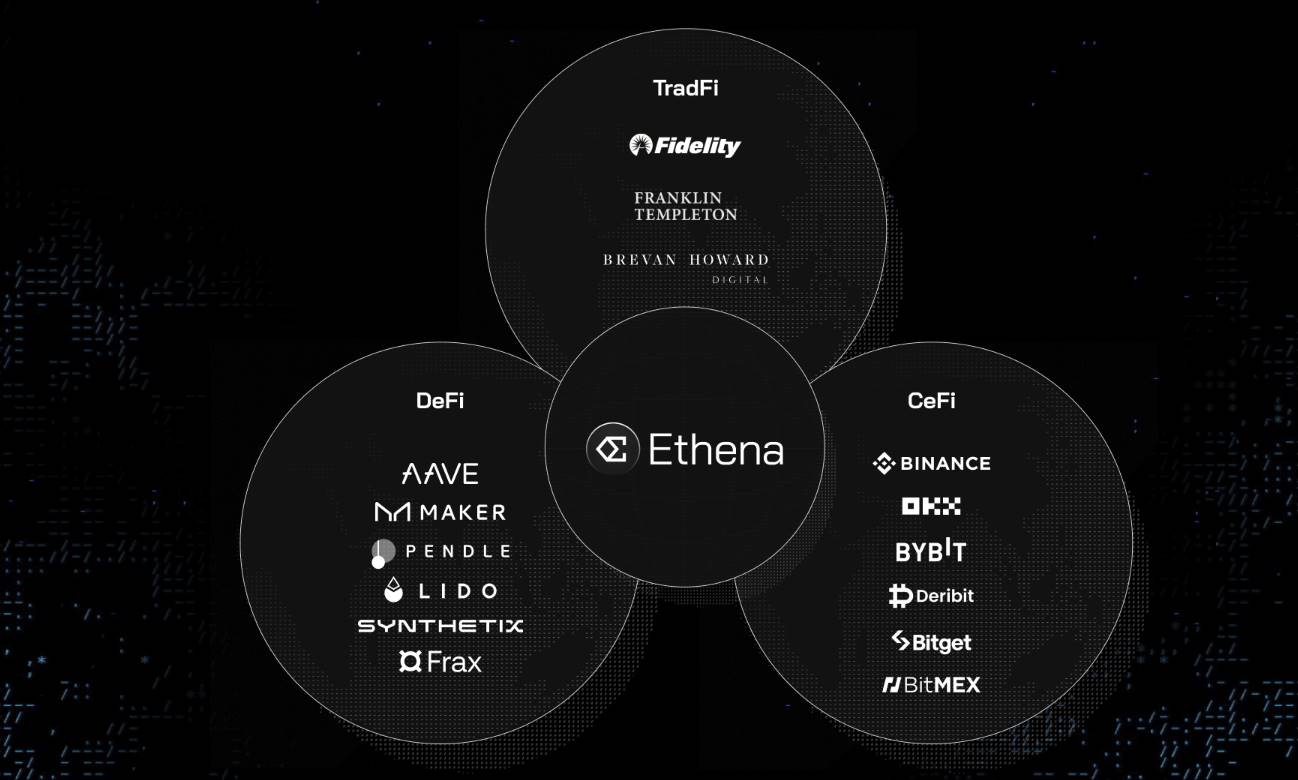
From the project's mission, Ethena aims to connect the funds in the CeFi, DeFi, and TradFi domains through the USDe stablecoin, and at the same time, Ethena captures the interest rate differentials in these three domains (exchanges, on-chain, traditional finance) to provide more returns to customers. If the USDe scale develops large enough, it may also drive the convergence of capital and interest rates between DeFi, CeFi, and TradFi.
The mechanism of the USDe stablecoin
Minting/Redemption mechanism: The minting/redemption of USDe can only be performed by the two independent legal entity minters (Ethena GmbH, Ethena BVI Limited) whitelisted. Minters need to use BTC/ETH/ETH LSTs/USDT/USDC as collateral to interact with the USDe Mint and Redeem Contract. As shown in the following images:

The first USDe minting on the Ethena protocol USDe Mint and Redeem Contract V1

A recent USDe minting based on the Ethena protocol USDe Mint and Redeem Contract V2

This is a record of redeeming USDe for USDT
During minting/redemption, the pricing of the Backing Assets is obtained from multiple different sources and continuously verified, including CeFi Exchanges, DeFi Exchanges, OTC Markets, as well as Pyth and RedStone Oracles, to ensure the correctness and reasonableness of the pricing.
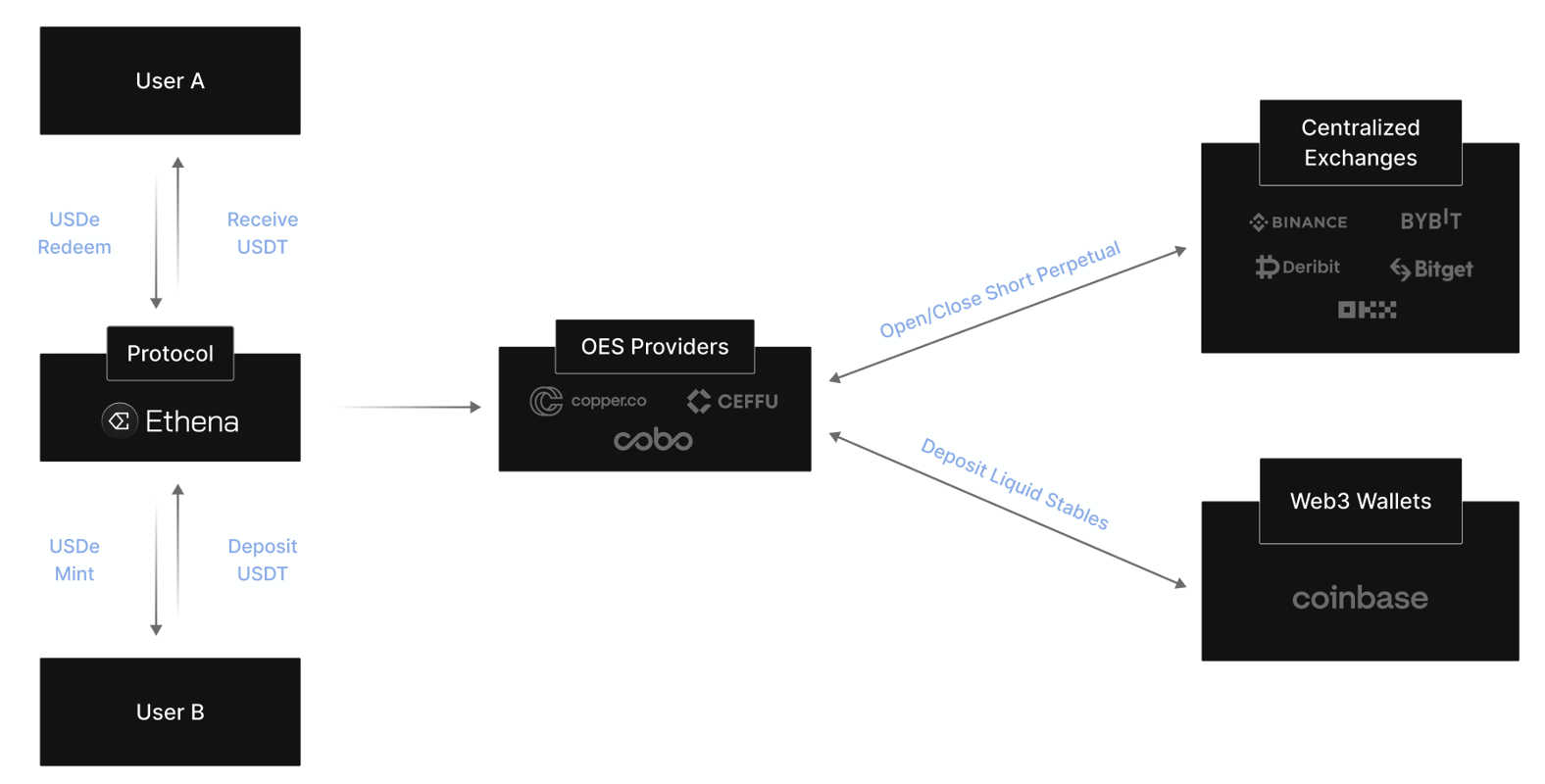
USDe stability maintenance mechanism: To ensure the stability of USDe, the key is to hedge the price fluctuations of the Backing Assets. Ethena adopts an automated, programmatic Delta-neutral hedging strategy.
The revenue sources of sUSDe
The revenue of sUSDe comes from Ethena's disposition of the collateral.
When Ethena receives the collateral, it can hold it as a stablecoin and earn a fixed deposit rate;
It can also delegate the collateral to selected CEXs to establish short futures positions to hedge the price fluctuations of the Backing Assets, while also earning the funding rate;
If the Backing Assets are ETH, Ethena can also perform Staking to earn the ETH Staking APR.
These earnings will be distributed to users in the form of returning more USDe when users redeem their sUSDe.
The use cases of the stablecoins (USDe/sUSDe/iUSDe)
In the DeFi domain:
USDe/sUSDe as collateral on lending protocol platforms like AAVE and Spark;
USDe/sUSDe as margin collateral on Perps DEX platforms;
USDe/sUSDe as collateral for Stablecoin protocols;
USDe/sUSDe as the underlying asset for interest rate swap protocols;
USDe as the pricing currency (trading pair) on Spot DEXs;
In the CeFi domain:
USDe as the pricing currency (trading pair) on CEXs;
In the TradFi domain:
iUSDe is the stablecoin launched by Ethena for the TradFi market, allowing regulated traditional companies to subscribe, so that these traditional investment institutions can provide the high returns of the Crypto market to their traditional clients without having to directly engage with Crypto.
III. Ethena's innovations
Delta-neutral hedging strategy to hedge the price fluctuations of Backing Assets
Many stablecoin projects that use Crypto Assets as Backing Assets ultimately become insolvent due to the lack of hedging against the price fluctuations of the Backing Assets. Ethena is the first project to implement an automated, programmatic Delta-neutral hedging strategy on the Backing Assets, making the portfolio's Delta value close to 0. Although Ethena's early Delta-Hedging algorithm and execution model were a black box, whether it can continuously maintain Delta-neutrality in the long run is a potential risk point, but this stability maintenance mechanism is an innovation. In the future, it may transition to an open-source RFQ model, where various market makers can compete to execute the hedging tasks.
Under normal circumstances, when redeeming USDe, the redemption is based on the 1 USDe = 1 USDC benchmark; if the hedging mechanism fails to work or the funding rate of the hedging futures positions incurs losses, leading to a decrease in the value of the asset reserves, then the redemption price for USDe holders will be proportionally reduced, and a 10 basis point compensation fee will be shown to the user.
Much higher capital efficiency than most stablecoin projects
Centralized stablecoins, like USDT and USDC, are heavily influenced by traditional financial regulations, and their collateral assets are mainly fiat currencies, primarily invested in US Treasuries and savings, with centralized single-point risks and low capital efficiency.
Decentralized stablecoins, like DAI from MakerDAO, generally require 120%-150% over-collateralization, and if considering the safety margin to avoid liquidation, the actual collateralization rate may exceed 200%, resulting in low capital efficiency, and in extreme market volatility, the collateral assets of customers may be liquidated, causing additional liquidation losses.
Ethena's USDe, in terms of collateral ratio, is close to 1 USD: 1 USDe, and with the Delta-neutral hedging strategy, the capital efficiency is very high, and the stability is also guaranteed.
More importantly, Ethena's positioning allows other projects in the stablecoin arena to also become Ethena's partners. For example, Sky, Frax, and Usual have already integrated/combined Ethena's products into their own products.
OES custody model ensures asset safety
Ethena currently collaborates with multiple custodians, including Copper, Ceffu, and Cobo. The collaboration adopts the OES (Off-Exchange Settlement) model, where the Backing Assets do not need to leave the on-chain wallet, so there is no need to worry about the risks of CEXs; nor the risks of the custodians, as the custodians cannot solely control these custodial assets. Taking Copper as an example, these Backing Assets are stored in an off-exchange vault, with Ethena, Copper, and the off-exchange vault each holding a key, and two parties need to sign to execute a transaction; or they are stored in a bankruptcy-remote trust.
Integrating traditional finance to grow USDe
Ethena connects the funds of CeFi, DeFi, and TradFi through the stablecoin USDe, and by capturing the interest rate differences between these three areas (exchanges, on-chain, and traditional finance), it can bring higher returns to clients.
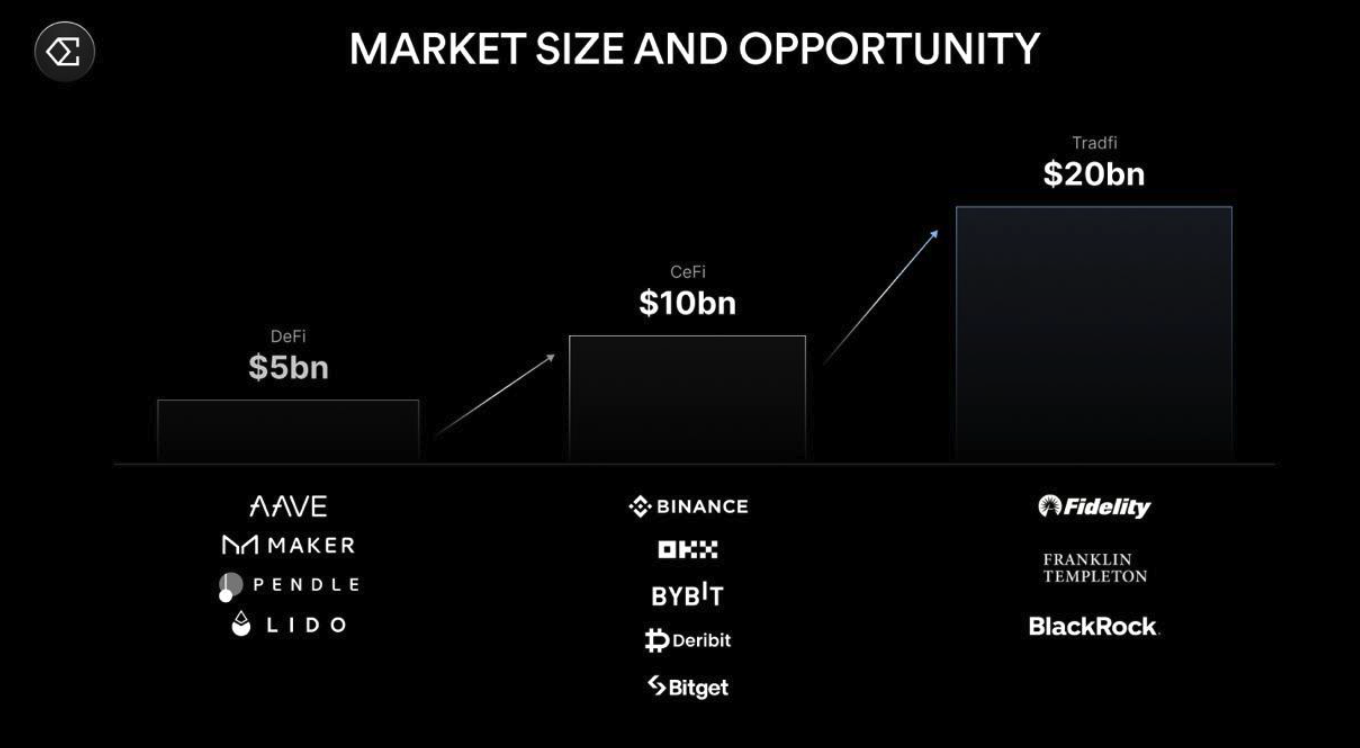
TradFi generally does not have many high-yield products, but the low-yield fixed-income market is very large in scale. In the Crypto field, the demand for leverage trading by users has led to more demand for currency (US dollar stablecoins), which has often led to "risk-free" high-yield opportunities in the Crypto industry.
Ethena acts as a bridge, integrating traditional finance to expand and strengthen USDe. When the Federal Reserve interest rate is very low (or in a rate cut cycle), Crypto trading will be more active, and the funding rate of Crypto market perpetual contracts will also be relatively high, and Ethena's short futures positions used for Delta hedging can earn more funding rates. This phenomenon occurs - when the returns in traditional finance are very low, clients can actually obtain higher returns through Ethena.
Therefore, iUSDe can meet the asset allocation needs of traditional finance clients during periods of low interest rates. This may also be part of the reason why Franklin Templeton and F-Prime Capital, the venture capital arm of Fidelity Investments, invested $100 million in Ethena's strategic round last December. In addition, the USDtb launched by Ethena in collaboration with BlackRock BUIDL may also drive a large amount of funds to flow from TradFi to Ethena and then to the Crypto market.
IV. Project Development Status
Ethena's USDe has become the third largest US dollar stablecoin. As of March 7, 2025, the issuance of USDe has reached over $5.5 billion, second only to USDT and USDC. The Transfer Volume ranks fourth, only behind USDT, USDC, and DAI. However, the number of Active Addresses is relatively small, with only 1,612, and the C-end application scenarios need to be expanded. Ethena's revenue has also developed rapidly, making it the second fastest crypto startup to reach $100 million in revenue, only behind Pump.fun.
Ethena has become a key cornerstone for many DeFi protocols. Over 50% of Pendle's TVL is attributed to Ethena; about 25% of Sky's revenue is attributed to Ethena; about 30% of Morpho's TVL earnings come from utilizing Ethena assets; Ethena is the fastest growing new asset on Aave; most EVM-based Perps have integrated USDe as collateral;
Ethena is building an ecosystem around USDe. According to the information on the Ethena website, two projects will be launched in Q1 2025 - the decentralized exchange platform Ethereal and the on-chain trading protocol Derive (supporting options, perpetuals, and spot trading). In terms of external cooperation, Ethena has also been very stable, collaborating with BlackRock to launch USDtb, and reaching a cooperation with the Trump family DeFi project World Liberty Financial.
Ethena also has some risk points:
The core earnings of USDe are unstable - as mentioned earlier, USDe has three main sources of earnings: one is the deposit interest rate earnings of the Backing Stablecoin, the second is the funding rate earnings of the short futures positions, and the third is the staking earnings of ETH in the Backing Assets. Among them, the funding rate of the futures positions may experience persistent negative funding rates during bear markets, leading to a deficit in USDe's earnings.
The CEX's ADL mechanism may cause the Delta neutral strategy to be ineffective - because CEXs have an automatic deleveraging (ADL) mechanism, which may affect Ethena's Delta neutral strategy during specific periods.
Partner relationships may bring liquidity risks - Bybit is the exchange with the highest adoption rate of USDe, holding nearly $700 million USDe at its peak. At the same time, Mantle (which merged with the Bybit co-founder's BitDAO ecosystem) is the second largest chain in terms of USDe supply. The recent Bybit hack incident triggered a redemption demand of over $120 million in USDe, and Ethena currently has $1.9 billion in Liquid Stables as Backing Assets, which is sufficient to cover these suddenly increased redemption demands. However, it cannot be ruled out that there may be a massive concentrated redemption exceeding its Liquid Stables reserves in the future, which could lead to short-term liquidity risks.
V. Investment Value of Ethena (ENA)
ENA currently has an FDV of $5.6B and a circulating market cap of $2B. Ethena has completed three rounds of financing, with amounts of $6M, $14M, and $100M respectively, with the second round valuation at $300 million, and the current token price still has over 18x returns.
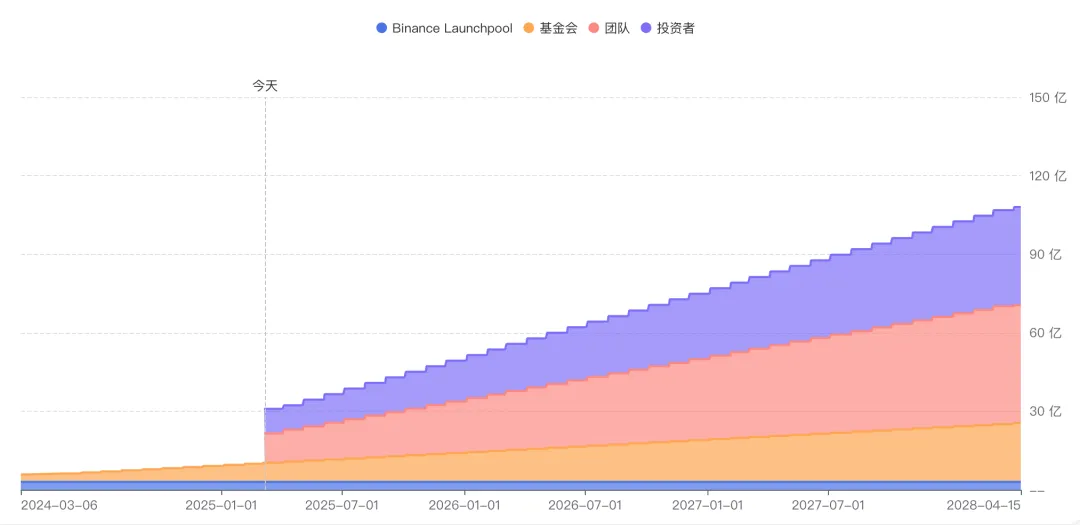
Before May 5, 2025, the circulating Tokens are mainly 2% from the Binance Launchpool, and the foundation and team shares are in linear unlocking. In April, some of the OTC purchase shares will start to unlock, with a cost price of about $0.25; starting from May 5, the shares of investment institutions will linearly unlock at a rate of over 7.8 million ENA per month.
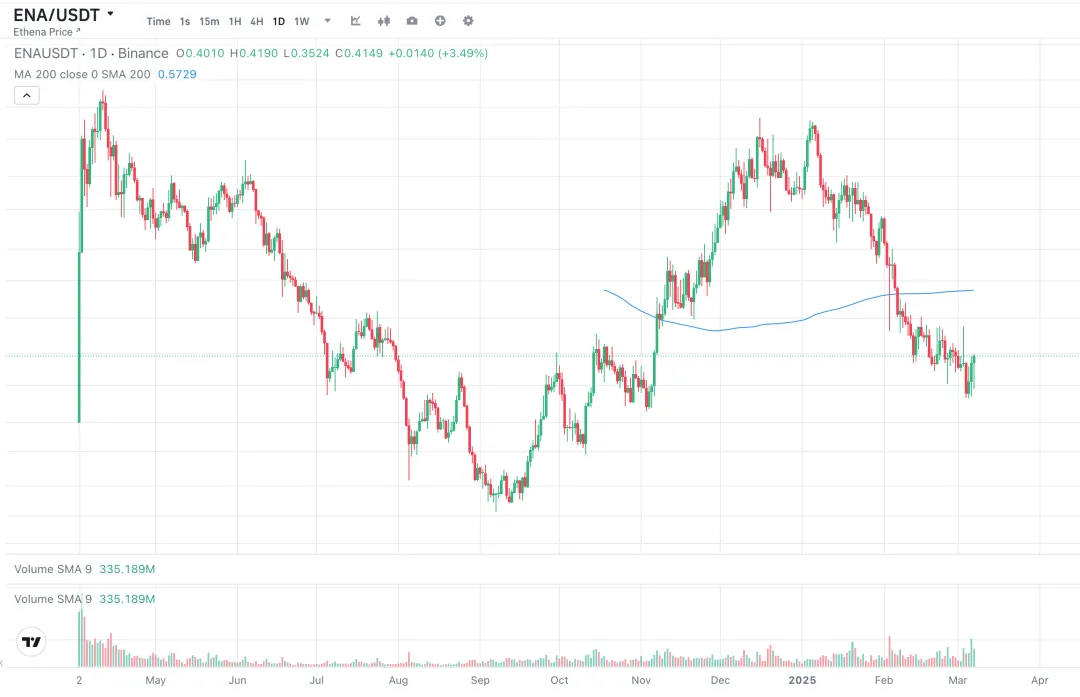
The recent overall crypto market pullback has weakened ENA's performance. BTC has retraced 25% from its high, ETH has retraced 50% from its high, and ENA has retraced about 70% from its high. The aforementioned upcoming ENA Token unlocks may have already been sufficiently reflected in the current token price.
In summary, Ethena's token price is under pressure in the short to medium term, but the core business of the project has long-term value.




